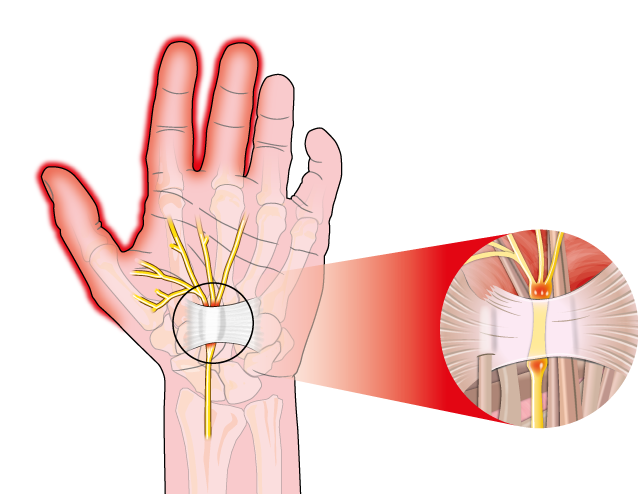An Ailment that’s Not Just for Computer Users
Computers are frequently blamed for carpal tunnel syndrome, a painful disorder involving a pinched nerve in the wrist. But assembly workers are three times more likely than data-entry personnel to suffer from it, according to the National Institute of Neurological Disorders and Stroke (NINDS).
The disorder is very common for those involved in manufacturing, sewing, finishing, and cleaning, as well as meat packing, NINDS officials say, although the risk is not limited to an industry or job. Women are three time mores likely to suffer from it than men, possibly because their carpal tunnels may be smaller, they say.
The carpal tunnel is a narrow passageway of bones and ligament at the base of the hand; it contains the median nerve and tendons. When irritation and swelling shrinks the cavity, the median nerve is compressed, potentially causing pain, weakness, and numbness in the hand, wrist, and arm. “Three sides of the tunnel are bone so there’s no give. That little tunnel does not expand to accommodate anything,” explains Dr. Patrick Sullivan, an orthopedic surgeon at Winter Haven’s Gessler Clinic. “If you start to get edema [swelling], there’s no escape. The nerve starts to malfunction.”
Initially, the disorder causes burning, tingling, itchiness and numbness to the hand, usually at night. The symptoms then occur during the day, eventually resulting in gripping problems, wasting away of muscles at the base of the thumb, and inability to distinguish between hot and cold.
Carpal tunnel syndrome often results from a combination of factors, including heredity. It can be triggered by diabetes, gout, rheumatoid arthritis, lupus or fractures, so a proper diagnosis is required. If there is a sick nerve, the underlying condition must be treated. An overactive pituitary gland, hypothyroidism, trauma or mechanical problems with the wrist, work stress and repeated use of vibrating hand tools, fluid retention, and cysts or tumors may be contributing factors.
Dr. Sullivan believes the cause is not work-related like people used to believe. “People will get symptoms sometimes just holding up a phone to their ear, or driving a car,” he says. “For a lot of people, their biggest problem is waking up at night.”
Dr. Sullivan has been performing surgery for carpal tunnel syndrome since 1966. He begins treatment with more “conservative” options like bracing or cortisone shots. Wrist immobilization splints may be worn exclusively at night, when many people sleep with flexed wrists, or in the daytime, as well.
Dr. Sullivan diagnoses the syndrome after a Nerve Conduction Velocity Test, which assesses electricity signals through the nerve. “I try not to do surgery,” he points out. “If they fail of course surgery is there.”
The operation, which costs roughly $1500 to $2,000, is an outpatient procedure with local anesthetic. The goal is to reduce pressure on the median nerve, which may be done by severing tissue around the wrist. When patients start having daily symptoms, he begins suggesting surgery. “It’s always elective surgery. The patient always has the right to decide what they want to do,” he says.
About 20 to 25 percent of Dr. Sullivan’s patients, many of them on Medicare, elect surgery. When a patient is properly diagnosed, the procedure is highly successful with no-long term negative effects, he says.
Symptoms may be relieved right away, but a full recovery can take months.
Patients whose jobs require only light physical activity may be able to return to work in a matter of days; construction workers and others may require a six-week recovery period.
At Lake Wales Medical Center, Occupational Therapist Annette Painter works with more complicated carpal tunnel cases, rehabilitating them for four to eight weeks following surgery. Her goal is to help patients by teaching them how to avoid aggravating symptoms.
She advises:
* Avoiding repetitious wrist bending and straightening
For computer users, manual laborers and others who work with their hands, this means finding ways to avoid bending wrists and fingers at the same time.
* Using your wrist in the neutral position, or outstretched straight in front of you, as
much as you can
* Avoiding pinching or picking up something with your wrist bent
* Decreasing swelling by applying hot and cold water alternately
* Doing specialized exercises to keep hands functioning and improve their capabilities.
It’s always best to seek a physician’s advice. “They shouldn’t take it on themselves to say ‘this is what my problem is,’” concludes Painter, who has worked with carpal tunnel since 1997.
Research has not conclusively shown changes in the workplace can avoid carpal tunnel syndrome, NINDS officials say. However, workers can try regular stretches, take frequent breaks, wear splints and maintain correct posture and wrist positioning. In some cases workstations may be redesigned to help employees keep their wrist straight while working or tasks at work can be rotated.
CREDITS
by CHERYL ROGERS
